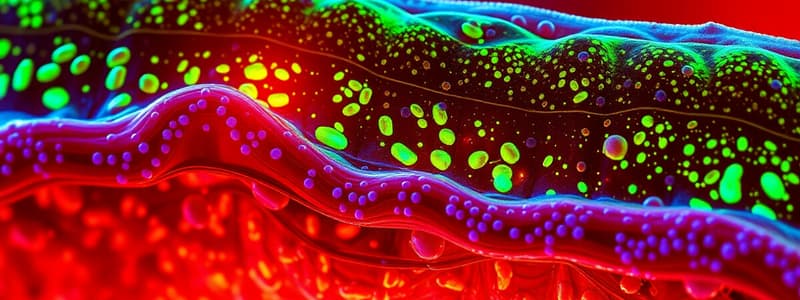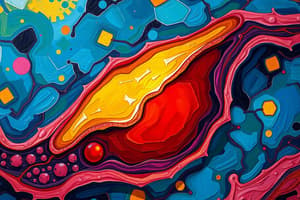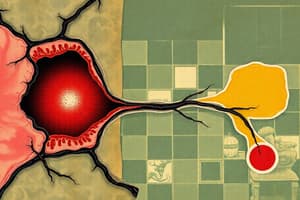Podcast
Questions and Answers
What type of cells are continuously replaced through programmed division of stem cells?
What type of cells are continuously replaced through programmed division of stem cells?
- Labile cells (correct)
- Granulation cells
- Stable cells
- Permanent cells
Which of the following best describes the process of regeneration?
Which of the following best describes the process of regeneration?
- Replacement of tissue by granulation tissue
- Closure of a wound with sutures
- Proliferation of cells and migration into a vacant space (correct)
- Formation of scar tissue due to injury
What is the primary mechanism involved in wound contraction?
What is the primary mechanism involved in wound contraction?
- Migration of granulation tissue
- Mechanical reduction of defect size (correct)
- Formation of scar tissue
- Rapid division of labile cells
Healing by first intention primarily occurs in which scenario?
Healing by first intention primarily occurs in which scenario?
What type of cells are classified as permanent cells?
What type of cells are classified as permanent cells?
Which factor does NOT influence the capacity of tissue for regeneration?
Which factor does NOT influence the capacity of tissue for regeneration?
What is a consequence of preventing wound contraction?
What is a consequence of preventing wound contraction?
How much does wound contraction typically reduce the size of a defect?
How much does wound contraction typically reduce the size of a defect?
What primarily affects the speed of healing by secondary union?
What primarily affects the speed of healing by secondary union?
Which systemic factor can delay wound healing significantly?
Which systemic factor can delay wound healing significantly?
What is a characteristic feature of a keloid scar?
What is a characteristic feature of a keloid scar?
During which stage of fracture healing does granulation tissue form?
During which stage of fracture healing does granulation tissue form?
Which complication is associated with excessive scar formation?
Which complication is associated with excessive scar formation?
Flashcards
Healing by second intention
Healing by second intention
Wound healing in areas with extensive tissue loss, like ulcers or abscesses.
Wound Healing Factors: Local
Wound Healing Factors: Local
Factors affecting wound healing that are directly related to the wound itself, like its size, cleanliness, and blood supply.
Infection's effect on wound healing
Infection's effect on wound healing
Infection hinders wound healing,potentially stopping it completely.
Wound dehiscence
Wound dehiscence
Signup and view all the flashcards
Keloid
Keloid
Signup and view all the flashcards
Regeneration
Regeneration
Signup and view all the flashcards
Repair (healing by scarring)
Repair (healing by scarring)
Signup and view all the flashcards
Labile cells
Labile cells
Signup and view all the flashcards
Stable cells
Stable cells
Signup and view all the flashcards
Permanent cells
Permanent cells
Signup and view all the flashcards
Wound contraction
Wound contraction
Signup and view all the flashcards
Primary Union (First Intention)
Primary Union (First Intention)
Signup and view all the flashcards
Secondary Intention
Secondary Intention
Signup and view all the flashcards
Study Notes
Healing Definition
- Healing is the body's replacement of damaged tissue with living tissue.
Types of Healing Processes
- Regeneration: Replacement of lost tissue with similar tissue types.
- Repair (Healing by Scarring): Replacement of lost tissue by granulation tissue, eventually forming a scar.
Wound Healing Process Steps
- Tissue Damage → Inflammation → Removal of Dead Tissue & Injury Agent → Replacement:
- Replacement occurs by either specialized tissues (regeneration) or fibrous tissue (scarring).
- This leads to healing.
Cell Types Based on Proliferative Capacity
- Labile Cells: Continuously turn over through stem cell division. Found in the surface epithelium of the gastrointestinal tract, urinary tract, and skin.
- Stable Cells: Have a lower replication rate than labile cells but can rapidly divide in response to injury. Examples include liver cells, endocrine glands, and renal tubular epithelium.
- Permanent Cells: Non-dividing cells. Replacement not possible if lost. Examples include adult neurons and lens cells.
Regeneration Process
- Proliferation: Division of surviving cells to replace lost tissue.
- Migration: Movement of surviving cells into the vacant space.
Factors Affecting Tissue Regeneration
- Proliferative Ability: The tissue's capacity for cell division.
- Damage to Stromal Framework: The structural support of the tissue.
- Type and Severity of Damage: The nature and extent of the injury.
Repair (Healing by Scarring) Details
- Repair involves the orderly replacement of lost tissue with a scar.
Wound Contraction
- Wound contraction is a mechanical process that reduces the size of a wound.
- Wounds contract by 70-80% of their original size.
- This process speeds up healing by decreasing the amount of damaged tissue needing replacement.
- Preventing contraction leads to slow healing & a large scar.
Types of Wound Healing
- Healing by First Intention (Primary Union):
- Occurs when a wound is clean, closed with sutures, and edges are approximate.
- The incision site is immediately filled, sealed and the area heals relatively quickly.
- A scab is often formed.
- Healing by Second Intention (Secondary Union):
- Occurs with extensive tissue loss/damage.
- Large defects are created. Examples include infarctions, ulcers, abscesses, and severe surface wounds.
- Healing is more drawn out.
Local Factors Affecting Wound Healing
- Wound Type, Size, and Location: Clean surgical incisions heal faster than wounds caused by blunt trauma.
- Vascular Supply: Adequate blood flow is crucial for delivering oxygen and nutrients to the healing area.
- Infection: Infections significantly delay or prevent healing.
- Ionizing Radiation: Radiation harms tissue and slows down the healing process.
Systemic Factors Affecting Wound Healing
- Circulatory Status: Poor circulation reduces the supply of nutrients and oxygen to the injured area.
- Metabolic Status: Poorly controlled diabetes impairs blood circulation and sensation and delays healing. Diseases and conditions can disrupt the wound healing process.
- Nutritional Deficiencies: Poor nutrition reduces healing speed and impairs wound repair processes.
- Hormones (Corticosteroids): Corticosteroids can hinder wound healing. Other hormones such as thyroid, androgens, estrogens, and growth hormone influence wound healing as well.
Complications of Wound Healing
- Infection: Bacteria entering the wound site can cause delays, or stop healing completely.
- Deficient Scar Formation: Results in conditions such as wound dehiscence (wound gap), incisions hernias, and ulcerations.
- Excessive Scar Formation: Results in raised scars (keloids) which can recur periodically. Hypertrophic scars are similar to keloids, but do not recur after surgical excision.
Bone Regeneration (Stages in Fracture Healing)
- Stage 1: Hematoma formation
- Stage 2: Inflammation
- Stage 3: Demolition (removal of dead tissue)
- Stage 4: Formation of granulation tissue
- Stage 5: Woven bone and cartilage formation
- Stage 6: Formation of lamellar bone
- Stage 7: Remodeling
Studying That Suits You
Use AI to generate personalized quizzes and flashcards to suit your learning preferences.




